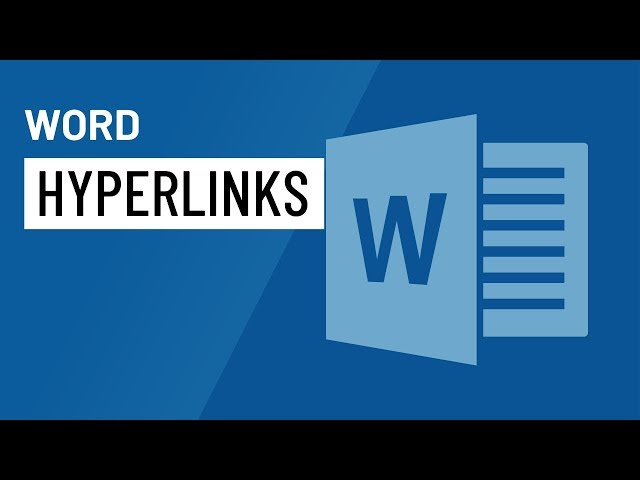
Introduction:
Microsoft Word 2016, a stalwart in the domain of word processing, transcends traditional text manipulation by integrating features that bridge the digital world seamlessly. Among these features, the ability to add hyperlinks stands out as a powerful tool for creating interconnected and dynamic documents. In this exhaustive guide, we will embark on a journey through the intricacies of adding hyperlinks in Word 2016, exploring the various types of hyperlinks, customization options, and tips for optimizing the user experience in document navigation.
Section 1: Understanding Hyperlinks
1.1 Defining Hyperlinks:
Hyperlinks, often referred to simply as links, are elements within a document that, when clicked, redirect users to another location. In the context of Word 2016, hyperlinks can connect to websites, email addresses, other documents, or specific locations within the same document, enhancing the document’s functionality and interactivity.
1.2 Types of Hyperlinks:
Word 2016 supports various types of hyperlinks, each serving a distinct purpose:
- Web Links: Directing users to external websites.
- Email Links: Launching email clients with pre-filled email addresses.
- Document Links: Navigating to other documents on the local system.
- Bookmark Links: Redirecting to specific locations within the same document.
Section 2: Adding Hyperlinks
2.1 Web Links:
Adding a hyperlink to a website in Word 2016 is a straightforward process. Users can select the desired text, navigate to the ‘Insert’ tab, choose ‘Link,’ and input the web address. This creates a clickable link, offering a convenient way to access external content.
2.2 Email Links:
For email hyperlinks, Word 2016 simplifies the process. Users can select the text, access the ‘Insert’ tab, choose ‘Link,’ and enter the email address in the appropriate field. This allows readers to initiate email correspondence directly from the document.
Section 3: Advanced Hyperlink Features
3.1 Document Links:
Word 2016 facilitates seamless document navigation by allowing users to create hyperlinks to other documents. This is particularly useful for cross-referencing or creating interconnected projects. Users can select text, go to the ‘Insert’ tab, choose ‘Link,’ and browse for the target document.
3.2 Bookmark Links:
To direct readers to specific locations within the same document, Word 2016 introduces bookmark links. Users can insert bookmarks at desired locations, select text, access the ‘Insert’ tab, choose ‘Link,’ and select the bookmarked location, creating an internal navigation system.
Section 4: Customizing Hyperlinks
4.1 Changing Hyperlink Appearance:
Word 2016 provides customization options to alter the appearance of hyperlinks. Users can modify the color and underline style of hyperlinked text, ensuring that links blend seamlessly with the document’s overall design.
4.2 Tooltips and ScreenTips:
Enhancing user experience, Word 2016 enables users to add tooltips and ScreenTips to hyperlinks. These pop-up messages provide additional information when users hover over a hyperlink, offering clarity on the destination or purpose of the link.
Section 5: Tips for Optimal Hyperlink Usage
5.1 Descriptive Link Text:
To enhance accessibility and user understanding, it is advisable to use descriptive link text. Instead of generic phrases like “Click Here,” opt for text that clearly conveys the hyperlink’s purpose or destination.
5.2 Testing Hyperlinks:
Before finalizing a document, users should thoroughly test hyperlinks to ensure they function as intended. This step guarantees a seamless user experience and prevents potential issues during document distribution.
Section 6: Collaborative Editing and Hyperlinks
6.1 Maintaining Hyperlink Integrity:
In collaborative environments, Word 2016’s collaborative editing features ensure the preservation of hyperlink integrity. Collaborators can make changes to the document without compromising the functionality of hyperlinks.
6.2 Shared Document Navigation:
Collaborators benefit from hyperlinks that facilitate shared document navigation. By strategically placing links to relevant sections or external resources, users can streamline collaboration and information retrieval within the document.
Section 7: Accessibility and Inclusivity
7.1 Descriptive Hyperlink Text for Screen Readers:
Consideration for accessibility is crucial when adding hyperlinks. Word 2016 allows users to provide descriptive text for screen readers, ensuring that individuals with visual impairments can navigate the document effectively.
7.2 Avoiding Overuse of Hyperlinks:
While hyperlinks are powerful, overusing them can clutter a document and overwhelm readers. Strategic placement and thoughtful use of hyperlinks contribute to a more effective and user-friendly document.
Conclusion:
Adding hyperlinks in Microsoft Word 2016 is more than just connecting text to external sources—it’s about creating a web of connectivity within your document. From web links to email addresses, document references to bookmarks, Word 2016’s diverse hyperlink features empower users to enhance document functionality and user experience. By understanding the various hyperlink types, exploring customization options, and implementing best practices, users can seamlessly integrate hyperlinks into their documents, fostering a dynamic and interconnected reading experience.